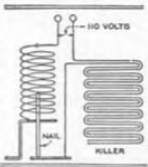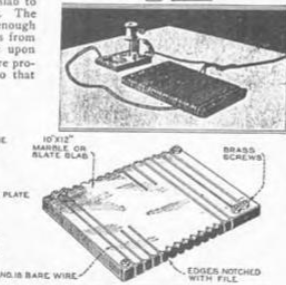Saxon's Survival Hour #180: Electric Bug Zapper
Today's excerpt begins on page 45 of The Survivor Volume 1.

Popular Mechanics 1925
Although the 110v house lighting current is ordinarily not fatal to the human body, it is very effective for electrocuting small animals and insects, because the resistance of these bodies is much less than that of the human body.
This explains the effectiveness with which the electric insect killer, shown in the illustration, disposes of roaches, flies, spiders, and other insects.
Once the apparatus is set up, it requires little or no attention, as it is automatic in its action, and there is no danger in having it connected continually.
The killer consists of a 10 by 12-in. slab of slate or marble with copper wire wound on it.
The edges are nicked with a file to hold the wire in place securely.
Care must be taken to get the nicks about 1/8in. apart so that the wires will run close to each other but will not actually touch.
The wire used for this purpose is preferably No. 18. and it must, of course, be bare.
Two separate lengths arc wound side by side so that the alternate wires will be of opposite polarity when connected to the circuit.
The ends of the wires are securely fastened to a pair of A-m brass screws at opposite corners of the slab to prevent the wires from unwinding.
The heads of these screws project far enough below the slab to prevent the wires from touching the surface of the table upon which it is laid, and single screw, arc provided on the other two corners so that the slab will rest solidly.
As soon as an insect craw ls or alights on the wired surface of this slab, on which sugar or other attractive bait is spread as a lure, it touches two wires of opposite polarity.and this allows a sufficient amount of current to flow through its body to kill it instantly.
It is not advisable to connect the wires of the slab directly to the lighting circuit as a small piece of metal, accidentally dropped on the wires, will blow a fuse. A small circuit breaker should be provided to prevent this. The construction of a simple one is shown in the lower left-hand detail.

It consists of a solenoid made by winding an ordinary thread spool full of No. 22 single cotton- covered copper head clipped off, as a plunger.
The solenoid is mounted on a brass bracket, which is bent to the shape shown, and screwed to a wooden base.
Through this bracket, directly under the hole in the spool, a hole is drilled for the plunger.
The spool is held on the bracket securely by small woodscrews driven in from underneath.
The height of the bracket should be a little less than the length of the plunger.
A small brass plate is fastened to the base so that the plunger rests on it when in its normal position, and a thumbnut is provided on the screw that holds this plate in place.
A second screw and thumbnut are provided as a separate terminal on the baseband to this terminal one end of the solenoid coil is connected, while the other end is soldered to the brass bracket.
Connections are then made to the lighting circuit and to the killer, as shown in the diagram in the upper right-hand corner.

The action of the solenoid is as follows: Current passes through the solenoid and over the bare wires of the killer whenever any two wires of opposite polarity are brought into electrical contact with each other, either through the body of the insect or a piece of metal, shorting them.
As soon as the current becomes excessive as it would naturally be in the latter case, the plunger is pulled up into the solenoid, and this breaks the circuit.
Of course, the moment that the current is broken the solenoid is demagnetised and the plunger drops again to its normal position, but if the same current still flows the process is repeated continually, causing the plunger to vibrate rapidly.
In operation the killer should, therefore, be set up on a slant so that every time an insect is killed it promptly falls off, preventing any long continued operation of the circuit breaker.
It is surprising how many insects will be killed by this death trap if it is located in the proper place and baited with some sweet-smelling substance.
The device can be left connected without any danger to the house wiring.
If desired, a .5 amp fuse can be inserted in the circuit to that in case the plunger sticks, the small fuse will be blown before the one in the lighting circuit.


Kurt Saxon thought civilization would have collapsed by now.
He spent the majority of his life collecting knowledge of home based business.
His goal was for all his readers to survive at a more comfortable level than those that were less provident.
He knew the importance of communicating at a level folks could understand.
Most of what he has compiled for our benefit can be easily understood by everybody.
He also includes a subtle sense of humor.
You can find the majority of his life's work here.
Hear him read his stories.
Posts with rewards set to burn only burn the author's portion of the rewards. Curators still get paid.
IF you think this content should be eligible for rewards from the content rewarding pool, please express your discontent in this discord:
What fun for boys that like to make their toys.
Thanks!
I still have something like that. I can say it is effective for mosquitos.
https://twitter.com/LovingGirlHive/status/1725421265840996679